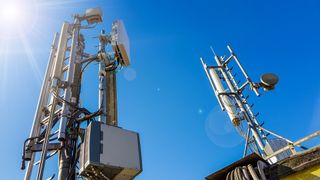Ofcom reveals fixed wireless roadmap to support 5G adoption
14GHz of new wireless spectrum will be opened up to enable new uses

Ofcom has officially unveiled its five-year plan for deploying fixed wireless links throughout the UK, in an effort to help accelerate the development and adoption of 5G networking.
Fixed wireless links are a networking technology that uses radio spectrum to transmit data between fixed geographic points, and is commonly used in conjunction with other forms of network infrastructure such as fibre cabling. It's often used to provide 'last mile' connectivity between individual premises and wider fibre network backbones, as well as providing backhaul for mobile networks.
The report was published following a public consultation in which the regulator heard from a number of different parties, including major network operators through to smaller businesses, on how they expect their usage of the wireless spectrum to change in the next five to ten years.
Frequency bands below 20GHz are expected to remain a crucial part of long-distance network infrastructure, according to Ofcom's findings. Bands in the 20 to 40GHz range are currently mainly used for mobile backhaul, but as fibre connectivity becomes more widespread, Ofcom predicts that this usage will shift to frequency bands above 60GHz. Other use-cases of fixed wireless, such as last mile connectivity, are expected to remain dependant on bands below 38GHz, but Ofcom is confident that there will be enough spectrum to support future uses of fixed wireless technology.
Ofcom expects significantly increased interest in bands above 45GHz. In addition to the growth of 60GHz bands for mobile backhaul use, the watchdog is also anticipating more interest in 70 and 80GHz bands, and the report noted that network operators are interested in seeing more spectrum added beyond the current 92GHz maximum frequency.
As part of the report, Ofcom announced that it is "taking immediate steps" to free up an additional 14GHz of spectrum for use, by reducing the regulatory restrictions on frequency bands between 57 and 66GHz and opening up new spectrum ranges between 66 and 71GHz. The latter frequencies are particularly intended to support new mobile 5G equipment and devices.
"We will focus our policy efforts on continuing to enable growth in the fixed wireless services sector taking into account the changes in spectrum use and requirements by other services," the report said. "We will do this by providing access to spectrum in ways that enables uses that provide the most benefits to citizens and consumers."
Get the ITPro. daily newsletter
Receive our latest news, industry updates, featured resources and more. Sign up today to receive our FREE report on AI cyber crime & security - newly updated for 2024.
"This will include the appropriate international frameworks and negotiating at an international level to achieve our objectives. We will also continue to monitor developments in this sector to understand where we may need to take further action in the future."
Adam Shepherd has been a technology journalist since 2015, covering everything from cloud storage and security, to smartphones and servers. Over the course of his career, he’s seen the spread of 5G, the growing ubiquity of wireless devices, and the start of the connected revolution. He’s also been to more trade shows and technology conferences than he cares to count.
Adam is an avid follower of the latest hardware innovations, and he is never happier than when tinkering with complex network configurations, or exploring a new Linux distro. He was also previously a co-host on the ITPro Podcast, where he was often found ranting about his love of strange gadgets, his disdain for Windows Mobile, and everything in between.
You can find Adam tweeting about enterprise technology (or more often bad jokes) @AdamShepherUK.





